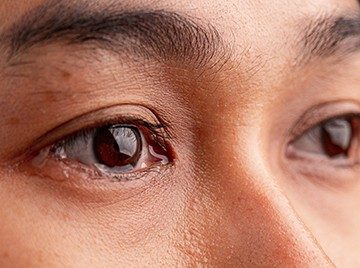FOR IMMEDIATE RELEASE | July 20, 2022
‘iTEARS’ could help diagnose diseases by isolating biomarkers in tears
Going to the doctor might make you want to cry, and according to a new study, doctors could someday put those tears to good use. In ACS Nano, researchers report a nanomembrane system that harvests and purifies tiny blobs called exosomes from tears, allowing researchers to quickly analyze them for disease biomarkers. Dubbed iTEARS, the platform could enable more efficient and less invasive molecular diagnoses for many diseases and conditions, without relying solely on symptoms.
Diagnosing diseases often hinges on assessing a patient’s symptoms, which can be unobservable at early stages, or unreliably reported. Identifying molecular clues in samples from patients, such as specific proteins or genes from vesicular structures called exosomes, could improve the accuracy of diagnoses. However, current methods for isolating exosomes from these samples require long, complicated processing steps or large sample volumes. Tears are well-suited for sample collection because the fluid can be collected quickly and non-invasively, though only tiny amounts can be harvested at a time. So, Luke Lee, Fei Liu and colleagues wondered if a nanomembrane system, which they originally developed for isolating exosomes from urine and plasma, could allow them to quickly obtain these vesicles from tears and then analyze them for disease biomarkers.
The team modified their original system to handle the low volume of tears. The new system, called “Incorporated Tear Exosomes Analysis via Rapid-isolation System” (iTEARS), separated out exosomes in just 5 minutes by filtering tear solutions over nanoporous membranes with an oscillating pressure flow to reduce clogging. Proteins from the exosomes could be tagged with fluorescent probes while they were still on the device and then transferred to other instruments for further analysis. Nucleic acids were also extracted from the exosomes and analyzed. The researchers successfully distinguished between healthy controls and patients with various types of dry eye disease based on a proteomic assessment of extracted proteins. Similarly, iTEARS enabled researchers to observe differences in microRNAs between patients with diabetic retinopathy and those that didn’t have the eye condition, suggesting that the system could help track disease progression. The team says that this work could lead to a more sensitive, faster and less invasive molecular diagnosis of various diseases — using only tears.
The researchers acknowledge funding from the National Natural Science Foundation of China; the Zhejiang Provincial and Ministry of Health Research Fund for Medical Sciences; the Basic Scientific Research Project of Wenzhou City; and Wenzhou Institute, University of Chinese Academy of Sciences.
To automatically receive press releases from the American Chemical Society, contact newsroom@acs.org.
Note: ACS does not conduct research, but publishes and publicizes peer-reviewed scientific studies.
Media Contact
ACS Newsroom
newsroom@acs.org


